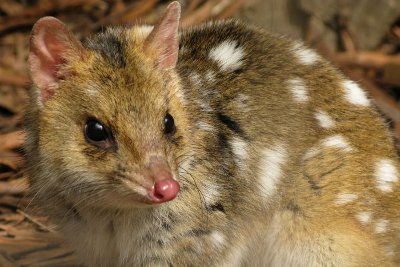Quoll
Category: Marsupial

Facts about Quolls. "Scientific name for Quollis Dasyurus Viverrinus". Quolls are carnivorous marsupial which are mainly found in Australia, New Guinea and Tasmania. Coming from a group of six species quolls have evolved for around fifteen million years ago in Miocene and the ancestors are believed to have diverged by around four million ago. These six species are; northern, tiger, eastern, southern, bronze and New Guinean quolls.
The Quoll vary in size and weight where the larger ones live longer than the smaller ones. The adult’s quolls are between 10 to 30 inches (25 and 75 cm) long. The largest among all is the tiger one which weighs up to 15.4 pounds (7 kgs). The smallest are the northern quolls that weigh between 14 to 32 ounces (400 to 900 grams) for the males and females 10.6 to 17.6 ounces (300 to 500 grams). Their tails are hairy and about 7 7/8 to 11 7/8 inches (20 to 35 cm) long. They either have black or brown fur and pink noses with long snouts.
The Females Quoll have six nipples and during the breeding seasons they develop a pouch. It opens towards the tail when they are young. The only exception is the tiger quolls which has a real pouch. Quolls reach maturity when they are one year old.
The Quoll normally stay alone but come together for mating purposes. The mating occurs during winter season and the gestation period lasts for 21 days. When the Quoll pups are born they are the size of grain rice. The female gives birth to around 18 puppies but unfortunately only six survive and suckle the mother in order to grow. The Quoll that survive stay in their mothers pouch for eight weeks and after that they get to their mothers back where they stay for six more weeks.
Quolls eat small birds, mammals like rabbits, lizards and insects. The natural lifespan of quolls is between two to five years. Though all the six species have declined in numbers, the eastern quolls have become completely extinct in Australian mainland. They are only found in Tasmania.
The Quoll main threats are human hunting, large snakes, crocodiles,urban development and poison baiting.

 Back To Category Marsupial
Back To Category Marsupial